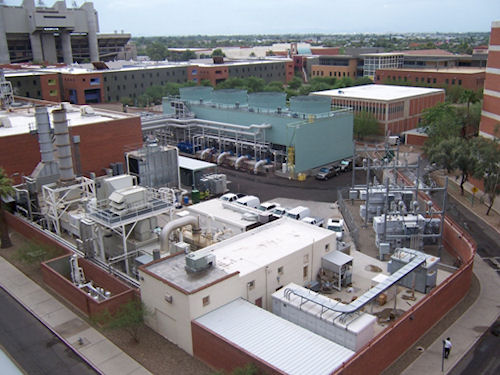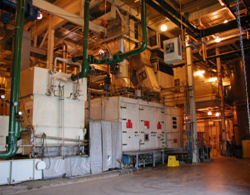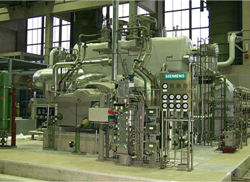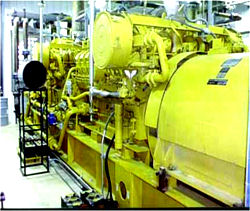Electric Generation Technologies for District Energy

The configuration at the University of Arizona is typical of many district energy systems: A
central plant generates electricity, recycles the thermal energy for cooling (or heating), and
distributes all the outputs to other buildings in the network. (Photo courtesy of GLHN)
Not all district energy systems include electricity generation - some are just heating, just cooling, or a combination of heating and cooling. But quite frequently, district energy systems do include an electricity component - especially all newer systems. The efficiency of the entire system yields very attractive electricity costs for all buildings connected to the system.
The prime movers for electric generation are similar to those used for combined heat and power (CHP). The main distinguishing factor is size - district energy systems can be quite large sine they supply a number of buildings. The most common prime movers for district energy are gas turbines, steam turbines, and large reciprocating engines. While fuels cells and microturbines could be used, their smaller size means they would need to have many units banded together, or be used in combination with one of the above larger technologies.
Gas Turbines

Courtesy: Princeton University Via Idea
Combustion or gas turbines are an established power generation technology available in sizes from several hundred kW to more than 100 MW. Gas turbines produce high-quality heat that can be used to generate steam for onsite use or for additional power generation (combined cycle). Gas turbines can be set up to burn natural gas, a variety of petroleum fuels, landfill or biogas, or can have dual-fuel capability. Gas turbines are well suited for CHP because their high-temperature exhaust can be used to generate process steam at conditions as high as 1,200 pounds per square inch gauge (psig) and 900 degrees Fahrenheit (°F). Much of the current US gas turbine-based CHP capacity consists of large combined-cycle CHP systems that maximize power production for sale to the grid while supplying steam to large industrial or commercial users. Simple-cycle CHP applications are common in smaller installations, typically less than 40 MW.
Appropriate for: District Energy; Medium and Large CHP
Further information:
- Gas Turbines chapter from the Catalogue of CHP Technologies (EPA CHP Partnership, PDF, 26 pgs)
Steam Turbines

Courtesy: Siemens
Steam turbines generate electricity from the heat (steam) produced in a boiler, converting steam energy into shaft power. Steam turbines are one of the most versatile and oldest prime mover technologies used to drive a generator or mechanical machinery. The energy produced in the boiler is transferred to the turbine through high-pressure steam that in turn powers the turbine and generator. This separation of functions enables steam turbines to operate with a variety of fuels, including natural gas, solid waste, coal, wood, wood waste, and agricultural by-products. The capacity of commercially available steam turbines ranges from 50 kW to more than 250 MW. Ideal applications of steam turbine-based CHP systems include medium- and large-scale industrial or institutional facilities with high thermal loads, and where solid or waste fuels are readily available for boiler use.
Appropriate for: District Energy; Large CHP; Large Waste Heat Recovery
Further information:
- Steam Turbines chapter from the Catalogue of CHP Technologies (EPA CHP Partnership, PDF, 21 pgs)
Reciprocating Engines

Courtesy: Cummins
Reciprocating internal combustion engines are the most widespread technology for power generation, commonly for small, portable generators to large industrial engines that power generators of several megawatts. Spark ignition engines for power generation generally use natural gas, though they can be set up to run on propane or landfill and biogas, and are available in sizes up to 5 MW. Reciprocating engines start quickly, follow load well, have good part-load efficiencies, and generally are highly reliable. In many instances, multiple reciprocating engine units can enhance plant capacity and availability. Reciprocating engines are well suited for applications that require hot water or low-pressure steam.
Appropriate for: Small District Energy; CHP
Further information: